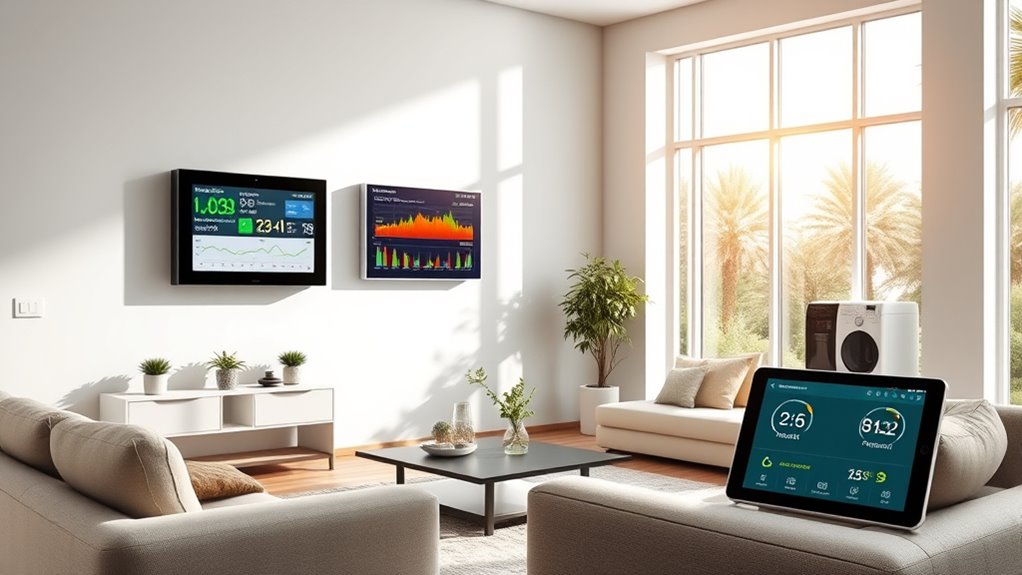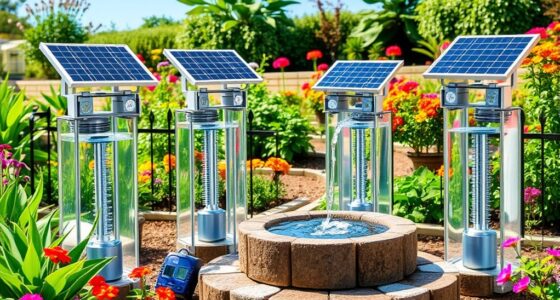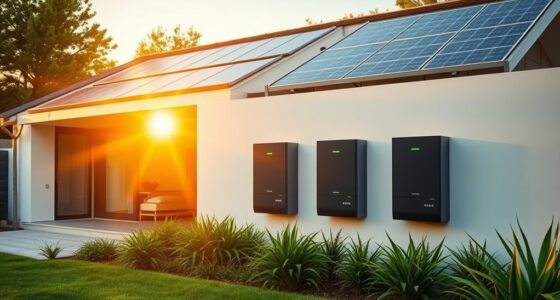I’ve explored top home energy monitors like the Emporia Vue 3, Sense Flex, and Siemens Inhab, which help identify waste, track costs, and optimize solar use. Most are easy to install and connect via WiFi or Ethernet for real-time data. They work with smart home platforms and support multiple circuits for detailed insights. Keep in mind features, compatibility, and costs. If you keep exploring, you’ll find the systems that best fit your energy-saving goals.
Key Takeaways
- Choose systems like Emporia Vue 3 for accurate real-time data and multi-circuit monitoring to identify energy waste effectively.
- Opt for models with solar and net metering support to optimize renewable energy use and reduce utility costs.
- Prioritize systems compatible with smart home platforms (Alexa, Google, Zigbee) for automation and remote energy management.
- Consider installation complexity and sensor options to ensure reliable setup and long-term energy savings.
- Look for UL and CE-certified monitors with secure data privacy features for safe, trustworthy energy tracking.
Emporia Vue 3 Home Energy Monitor
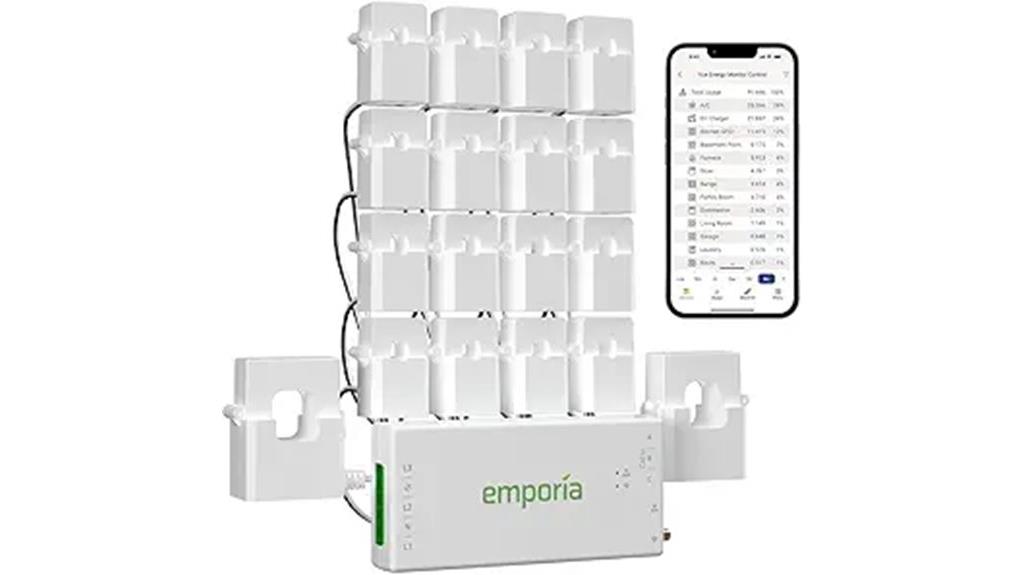
Are you looking for a reliable home energy monitor that offers precise data and easy installation? The Emporia Vue 3 fits the bill perfectly. It’s UL Listed and CE Certified, so you can trust its safety and quality. Installing it is straightforward—you can set it up within most home circuit panels using clamp-on sensors. It supports a variety of systems, including single-phase and split-phase setups, with optional sensors for more complex wiring. The Vue 3 provides real-time energy data with ±2% accuracy, accessible via your smartphone or web app. Plus, it helps you identify savings opportunities and optimize your energy use effortlessly.
Best For: homeowners seeking a safe, easy-to-install energy monitoring solution that provides precise real-time data and appliance-level insights.
Pros:
- UL Listed and CE Certified ensuring high safety and quality standards
- Supports a wide range of wiring systems including single-phase, split-phase, and with optional sensors for complex setups
- Provides accurate real-time energy data accessible via smartphone and web app with detailed appliance insights
Cons:
- Requires a stable 2.4 GHz Wi-Fi connection for optimal performance
- Additional sensors for complex wiring systems are sold separately, increasing overall cost
- Limited to 3-hour data storage in the cloud when app is open, which may require frequent data exports for long-term analysis
Smart Home Energy Monitor with 16 50A Circuit Level Sensors
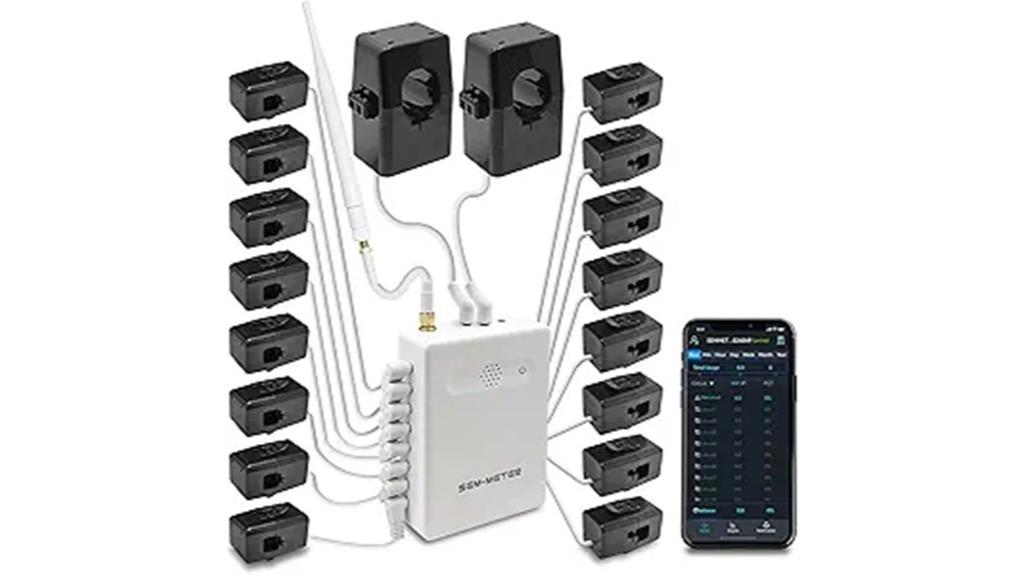
The Smart Home Energy Monitor with 16 50A circuit sensors is an ideal choice for homeowners seeking all-encompassing, real-time insight into their entire household energy consumption. It supports various electrical systems, including single-phase, split-phase, and three-phase setups, making it versatile for most homes. Installation is straightforward with clamp-on sensors that fit most circuit panels, and it connects via WiFi for remote access. With detailed data available through a user-friendly app, you can monitor power usage across appliances and systems, identify energy waste, and reduce costs. This monitor helps promote energy efficiency while offering reliable, exhaustive insights into your home’s energy profile.
Best For: Homeowners seeking comprehensive, real-time energy monitoring across various electrical systems to optimize efficiency and reduce costs.
Pros:
- Supports multiple electrical configurations including single-phase, split-phase, and three-phase systems for versatile installation.
- Provides detailed, real-time energy data accessible remotely via a user-friendly app.
- Easy clamp-on installation compatible with most circuit panels, with no batteries required.
Cons:
- Limited to monitoring up to 415Y/240VAC three-phase systems (no Delta support).
- Requires WiFi connectivity for remote features, which may be a limitation in weak signal areas.
- Excludes batteries, so it depends entirely on external power and network for operation.
Smart Home Energy Monitor with 16 Circuit Level Sensors
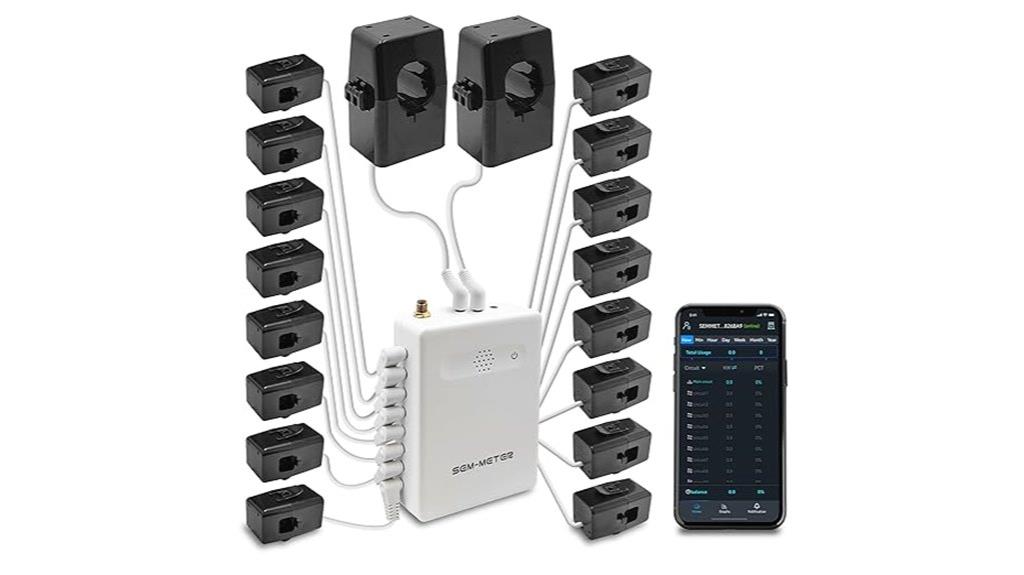
For homeowners seeking all-encompassing energy insights, the Smart Home Energy Monitor with 16 Circuit Level Sensors stands out as an ideal choice. It’s easy to install in most circuit panels with clamp-on sensors and supports various configurations, including single-phase and three-phase systems. The monitor provides real-time data via WiFi with 1% accuracy, tracking current, voltage, and power, while the app allows for detailed load analysis, circuit labeling, and cost estimates. It integrates seamlessly with Home Assistant and supports solar and net metering. Overall, it’s a reliable, precise, and versatile system that helps you identify energy hogs and cut costs efficiently.
Best For: homeowners and energy-conscious individuals looking for comprehensive, real-time energy monitoring and cost-saving insights across multiple circuits and system configurations.
Pros:
- Easy to install with clamp-on sensors suitable for most circuit panels.
- Offers highly accurate real-time data (within 1%) on current, voltage, and power.
- Seamless integration with Home Assistant and support for solar/net metering features.
Cons:
- Lacks a WiFi antenna grommet, which may affect durability or signal quality in some installations.
- Slight under-reporting compared to utility meters, though within acceptable margins.
- Limited to non-Delta three-phase setups, so certain industrial or complex systems may not be compatible.
SIEMENS Inhab Smart Home Energy Monitor
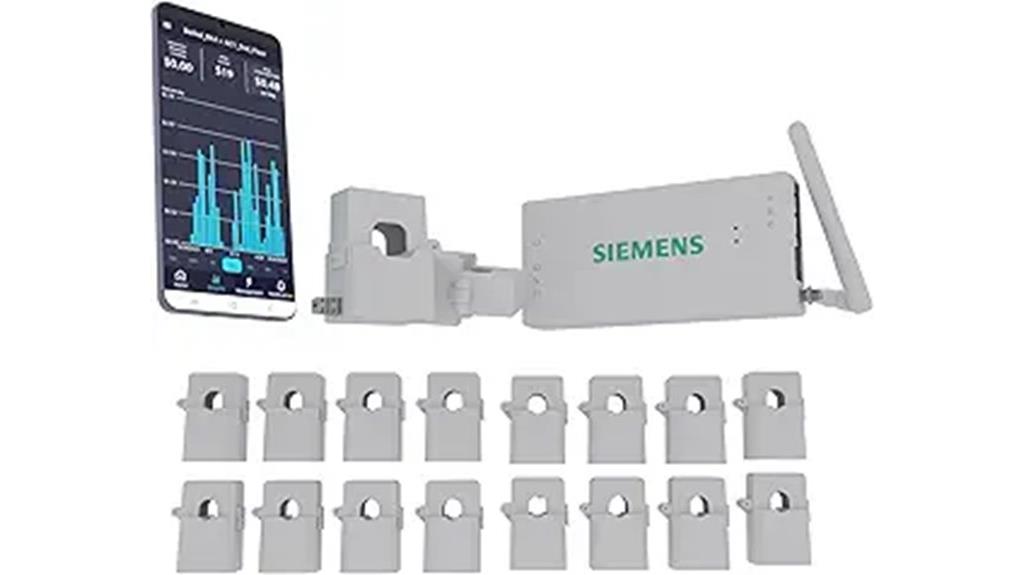
If you’re looking for an affordable, detailed home energy monitoring system that connects directly to your electrical panel, the Siemens Inhab Smart Home Energy Monitor stands out. It measures real-time energy use and production, supporting up to 16 circuits with 50A CT sensors and 2 main circuits with 200A sensors. The device provides instant data via cloud and mobile app, helping you identify high consumption, manage peak demand, and optimize solar integration. Installation requires a licensed electrician, and wiring can be challenging in tight panels. Overall, it’s an effective, budget-friendly solution for homeowners wanting detailed energy insights and control.
Best For: homeowners seeking an affordable, detailed energy monitoring system that integrates directly into existing electrical panels for real-time insights and energy management.
Pros:
- Supports monitoring up to 16 circuits and 2 main circuits, providing comprehensive energy data.
- Cloud and mobile app access for real-time and historical energy analysis.
- Budget-friendly alternative to traditional circuit monitoring systems with high accuracy.
Cons:
- Installation can be challenging in tight electrical panels, especially with wiring and sensor placement.
- Short Wi-Fi antenna leads may require additional routing solutions.
- Limited international compatibility and app access outside the USA may restrict usability for some users.
Smart Home Energy Monitor with 2 x 120A CTs
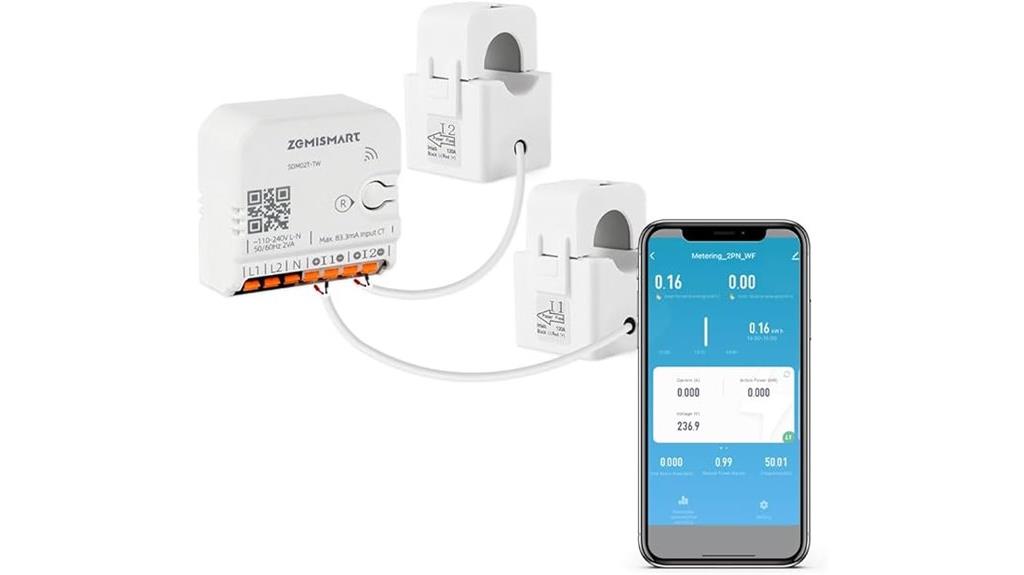
A smart home enthusiast seeking precise, real-time energy tracking will find the Smart Home Energy Monitor with 2 x 120A CTs to be an excellent choice, especially for single-phase 3-wire systems. It offers bi-directional power monitoring, supporting voltage, current, power, and total energy with Class 1 accuracy—perfect for solar and battery systems. Easy to install with pluggable terminals and split-core CTs, setup takes about 15 minutes. Compatible with the Smart Life app, it enables real-time data analysis, alerts, and automation. Despite some user challenges with pairing and app detection, it provides reliable household energy management and seamless integration with home automation systems.
Best For: smart home enthusiasts and energy-conscious homeowners seeking precise, real-time monitoring of single-phase 3-wire systems with solar and battery integration.
Pros:
- Supports bi-directional power tracking with Class 1 accuracy for solar and grid export measurements
- Easy installation with pluggable terminals and split-core CTs, taking approximately 15 minutes
- Compatible with Smart Life app and home automation platforms like Home Assistant for real-time data, alerts, and automation
Cons:
- Users may experience difficulties with app pairing, device detection, and manual setup instructions
- Some reported hardware issues, such as units not powering on or connection problems
- Limited detailed US-specific installation guidance in the manual, which could pose challenges for some users
Home Energy Monitor with WiFi/Ethernet Connectivity
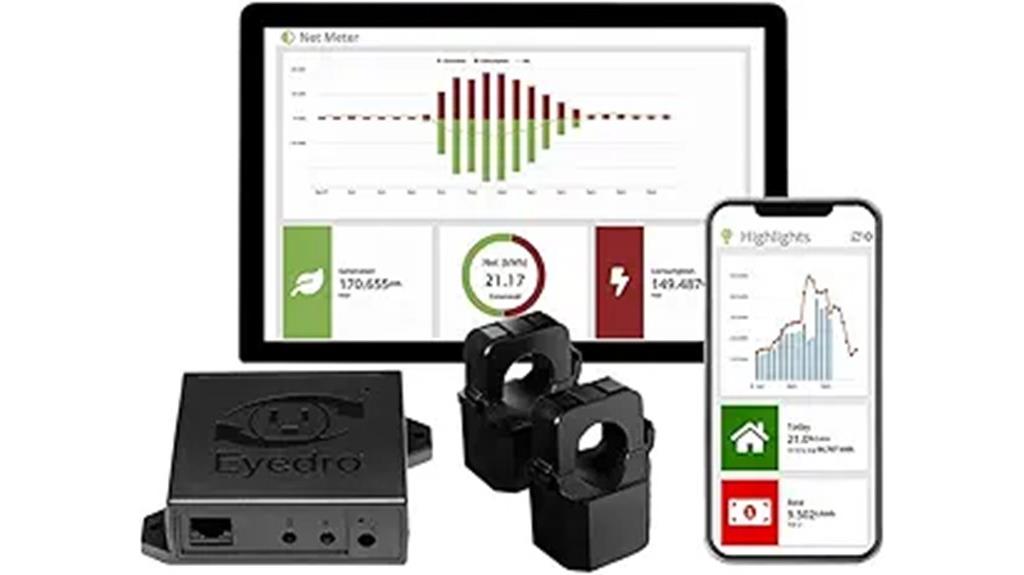
The Home Energy Monitor with WiFi/Ethernet Connectivity stands out for its seamless real-time data access through popular network options, making it ideal for those who want instant insights into their energy use. It connects via WiFi or Ethernet, providing continuous monitoring of solar and grid energy with two 200A sensors. The system supports solar integration and net metering, helping optimize solar utilization and lower costs. The MyEyedro cloud platform offers detailed reports, live data, and alerts without extra fees. Its mobile-friendly design guarantees you can track energy patterns anytime, helping you make smarter energy decisions right from your phone or computer.
Best For: homeowners and solar energy users seeking real-time, reliable energy monitoring and cost-saving insights through a WiFi or Ethernet-connected system.
Pros:
- Offers seamless real-time data access via WiFi or Ethernet, ensuring continuous monitoring.
- Supports solar integration and net metering for optimized energy usage and cost savings.
- No subscription fee for comprehensive cloud-based reports, alerts, and detailed energy insights.
Cons:
- Limited to North American 120VAC power standards, restricting international use.
- Requires a stable WiFi or Ethernet connection for optimal performance; may not work well with poor network signals.
- Hardware setup includes sensors and cables that may be complex for some users to install without technical support.
Sense Energy Monitor with Solar
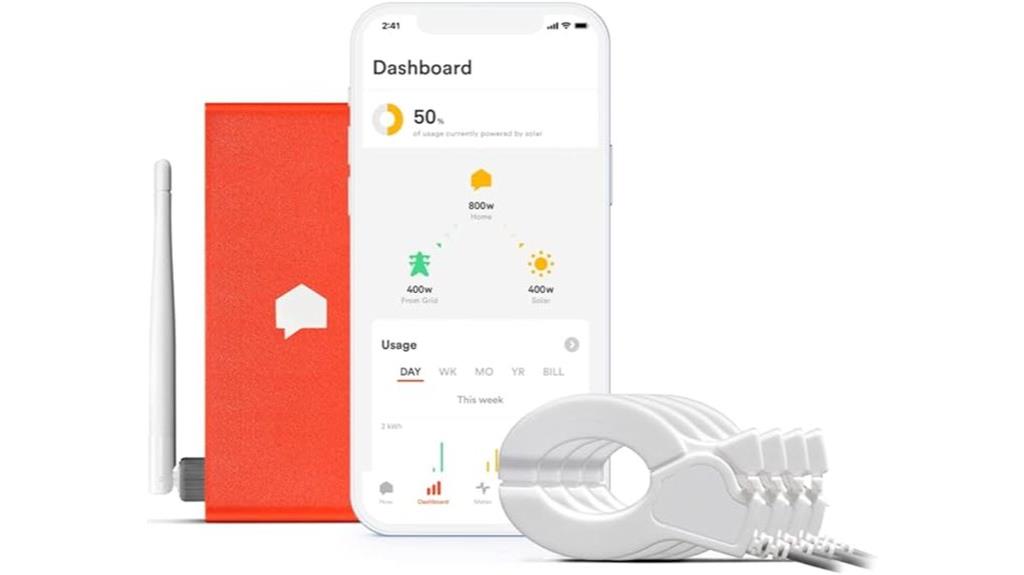
Sense Energy Monitor with Solar stands out for homeowners who want all-encompassing real-time tracking of both their electricity use and solar energy production. Certified to meet strict safety standards, it installs inside electrical panels and provides detailed insights into energy consumption and generation. The system learns appliance patterns over time, helping identify inefficiencies, while manual tagging with smart outlets improves accuracy. It supports optimizing solar energy, managing peak rates, and reducing costs—sometimes paying for itself quickly. Although installation can be complex and may require professional help, the device’s responsive support and comprehensive data make it a powerful tool for smarter energy management.
Best For: homeowners seeking comprehensive real-time monitoring of both electricity consumption and solar energy production to optimize energy use and reduce costs.
Pros:
- Provides detailed, real-time insights into home energy and solar production, enabling smarter energy management.
- Supports appliance detection and manual tagging for improved accuracy, helping identify inefficiencies.
- Certified to meet strict safety standards and compatible with various smart home devices, including smart outlets and thermostats.
Cons:
- Installation can be complex and may require professional electrical assistance, especially with solar integration.
- Learning algorithms may initially misidentify appliances, requiring manual adjustments and patience.
- Limited international compatibility, designed primarily for US and Canadian electrical standards.
Emporia Energy Monitor with Sensors and Smart Plugs Bundle
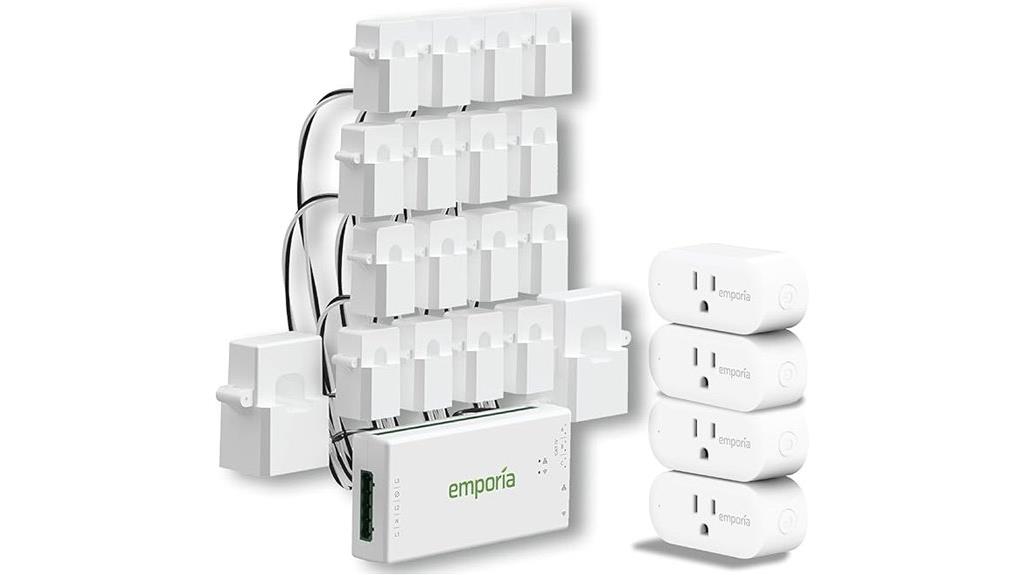
For homeowners seeking extensive energy oversight, the Emporia Energy Monitor with Sensors and Smart Plugs Bundle stands out by offering real-time, whole-home tracking along with device-level control. It includes the Emporia Vue Energy Monitor with 16 sensors to track energy use from the main panel and up to 16 circuits, providing second-by-second data and supporting solar net metering. The bundle also features four Wi-Fi smart plugs, enabling remote control, scheduling, and energy savings at the outlet level. Managed via the free Emporia app, it offers detailed insights, automation, and cloud storage — helping you optimize energy use, cut costs, and prevent costly repairs.
Best For: homeowners looking for comprehensive, real-time energy monitoring and device-level control to optimize their energy consumption and reduce costs.
Pros:
- Provides second-by-second energy data from the main panel and up to 16 circuits for detailed insights
- Includes four Wi-Fi smart plugs for remote control, automation, and outlet-specific energy management
- Supports solar net metering and offers cloud-based data storage for real-time tracking and analysis
Cons:
- Requires installation of sensors and smart plugs, which may be complex for some users
- Limited to 16 circuits; may not cover very large or highly complex electrical systems
- The initial setup and app configuration could be time-consuming for non-technical users
Emporia Vue 3 Commercial Smart Energy Monitor
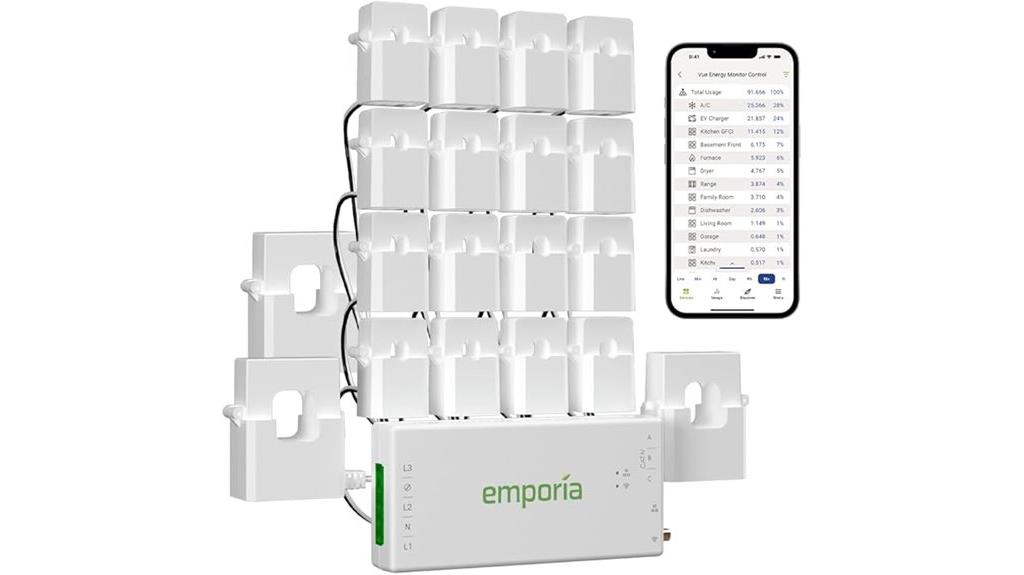
Looking for a reliable energy monitor that can handle complex electrical systems? The Emporia Vue 3 Commercial Smart Energy Monitor fits the bill perfectly. It supports single-phase, split-phase, and 3-phase systems, making it ideal for small businesses and larger homes. With 16 circuit sensors and clamp-on options, it delivers detailed real-time energy data. Easy to install with some electrical knowledge, it provides accurate readings via a user-friendly app. Customers praise its reliability, quick reports, and helpful diagnostics. While it lacks voltage logging and customizable data views, it’s a solid choice for those wanting all-encompassing energy monitoring and better control over their electricity use.
Best For: small to large businesses and homeowners seeking comprehensive, real-time energy monitoring of complex electrical systems.
Pros:
- Supports a wide range of electrical systems including single-phase, split-phase, and 3-phase setups
- Provides detailed energy data with 16 circuit sensors and clamp-on options
- Easy to install with reliable, fast data reporting and user-friendly app interface
Cons:
- Lacks voltage data logging and customizable data viewing options
- Export data only shows wattage, limiting detailed analysis
- Some circuits may require professional electrician installation
Sense Energy Monitor
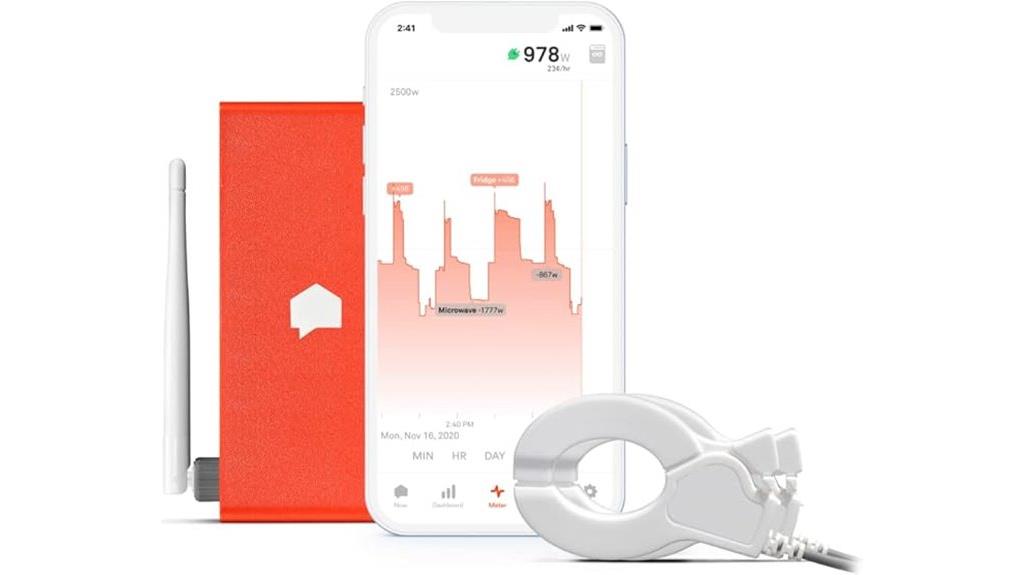
If you’re seeking a home energy monitor that offers real-time insights and helps you save money, the Sense Energy Monitor is an excellent choice. It tracks your electricity usage instantly, supports time-of-use rate plans, and is certified for safe installation inside electrical panels. With Sense, you get detailed data on your devices and appliances, so you can identify what’s consuming power and when. You can access this information remotely via iOS, Android, or web apps, making it easy to monitor your home from anywhere. Customizable alerts notify you of abnormal activity, helping prevent issues and optimize energy efficiency. Note that it’s only available in the U.S. and Canada.
Best For: homeowners in the U.S. and Canada seeking real-time energy monitoring to reduce costs and improve efficiency.
Pros:
- Provides detailed, real-time insights into household energy consumption.
- Supports remote monitoring via iOS, Android, and web apps for convenience.
- Certified for safe installation inside electrical panels, meeting safety standards.
Cons:
- Only available for purchase and use within the United States and Canada.
- May require professional installation due to electrical panel certification.
- Does not include integration with smart home devices beyond energy monitoring features.
Smart Home Energy Monitor with Circuit Sensors
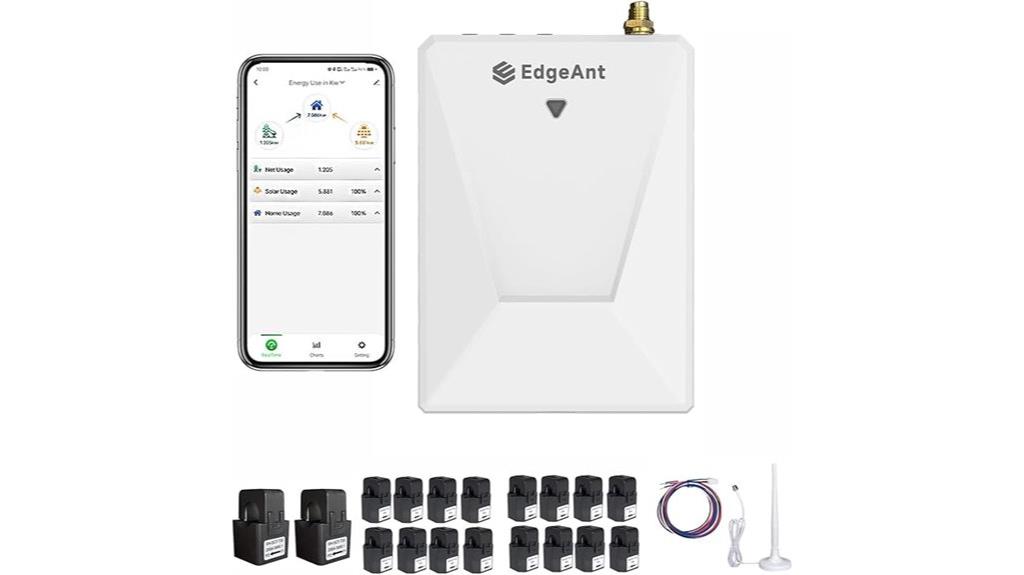
The Smart Home Energy Monitor with Circuit Sensors stands out as an ideal choice for homeowners seeking precise, real-time energy tracking of major appliances. It features 16×50A and 2×200A sensors, perfect for monitoring air conditioners, water heaters, and large panels. With WiFi connectivity, it provides accurate data on voltage, current, and energy usage, supporting bidirectional measurement with ±2% accuracy. Easy to install—just clamp onto power cables—it enables effective management and alerts to reduce energy waste. Supporting integration with Tuya devices, it helps you lower bills, conserve energy, and promote sustainability effortlessly. Proper installation by qualified personnel guarantees safety and reliable operation.
Best For: homeowners who want precise, real-time monitoring of their major appliances to optimize energy use and reduce costs.
Pros:
- Provides accurate, real-time data on voltage, current, and energy consumption with ±2% precision.
- Easy installation with clamp-on sensors, suitable for various load types and panels.
- Supports integration with Tuya smart devices for expanded home automation and control.
Cons:
- Installation should be performed by qualified personnel to ensure safety and proper functioning.
- Incorrect sensor placement may result in negative readings, affecting data accuracy.
- Requires stable 2.4 GHz WiFi connection; setup can be complex for non-technical users.
Upgraded Watt Power Meter Plug for Home Electrical Monitoring
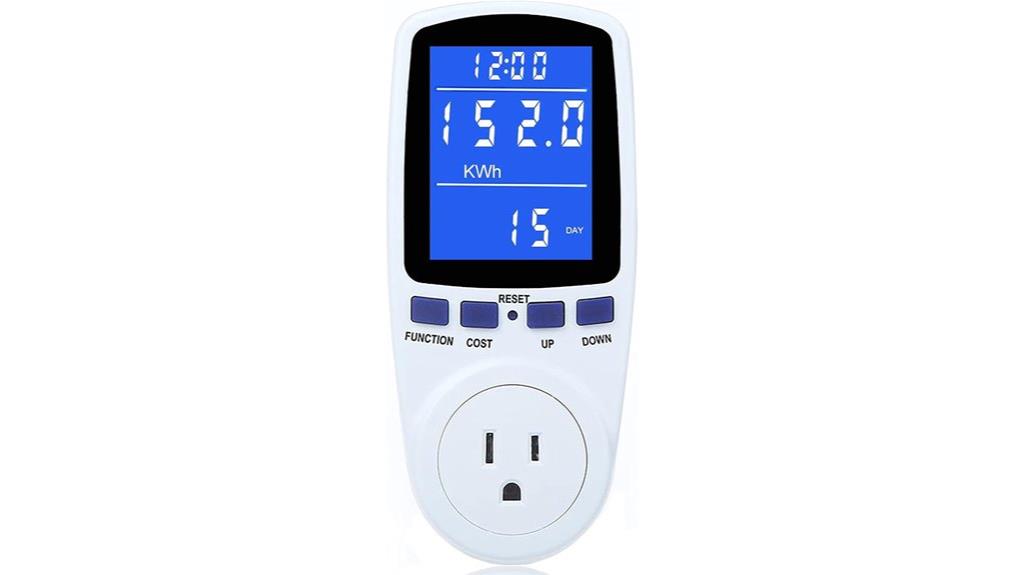
The Upgraded Watt Power Meter Plug stands out as an excellent choice for homeowners seeking precise and all-encompassing electrical monitoring. It tracks power (W), energy (kWh), volts, amps, frequency, power factor, and cost, giving a detailed view of appliance efficiency. The device records peak and minimum readings, cumulative days, and runtime, with data memory that saves info even during outages. Its large, backlit LCD display is easy to read from any angle, and adjustable backlight settings enhance usability. Overload protection warns when limits are exceeded, ensuring safety. Overall, it’s a reliable, cost-effective tool for managing energy consumption and cutting costs.
Best For: homeowners and energy-conscious individuals seeking an accurate, comprehensive, and easy-to-use device for monitoring household electrical consumption and reducing energy costs.
Pros:
- Provides detailed monitoring of multiple parameters including power, energy, volts, amps, frequency, power factor, and cost.
- Large, backlit LCD display with customizable backlight settings for clear visibility day or night.
- Equipped with overload protection and data memory that saves information during power outages, ensuring reliable tracking over time.
Cons:
- Lacks official certification, which may raise safety concerns for some users.
- Requires manual configuration for accurate readings and setting safety parameters.
- Does not have a built-in clip or holder for resetting tools or extra accessories.
Sense Flex Home Energy Monitor
Sense Flex Home Energy Monitor stands out for its ability to track multiple circuits and systems simultaneously, making it ideal for homeowners with complex energy setups. It combines the Sense monitor with Flex sensors, supporting up to two 120V/240V circuits, solar, generator, or split-service systems. With real-time data accessible via iOS, Android, and web apps, you can monitor energy use from anywhere. It also offers customizable alerts for critical devices, helping prevent issues and enhance safety. Designed for homes in the U.S. and Canada, the Sense Flex provides detailed insights into energy consumption, empowering you to become more efficient and save money.
Best For: homeowners with complex energy systems in the U.S. or Canada seeking real-time monitoring and customizable alerts to optimize energy use and enhance safety.
Pros:
- Supports monitoring multiple circuits, solar, generator, and split-service systems simultaneously
- Provides real-time data access through iOS, Android, and web apps from anywhere
- Enables customizable alerts for critical devices to prevent issues and improve safety
Cons:
- Only available for homes in the United States and Canada
- May require professional installation for complex wiring setups
- Limited to monitoring up to two 120V/240V circuits, which might not suit very large or industrial systems
TP-Link Tapo Smart Plug 4-Pack with Energy Monitoring
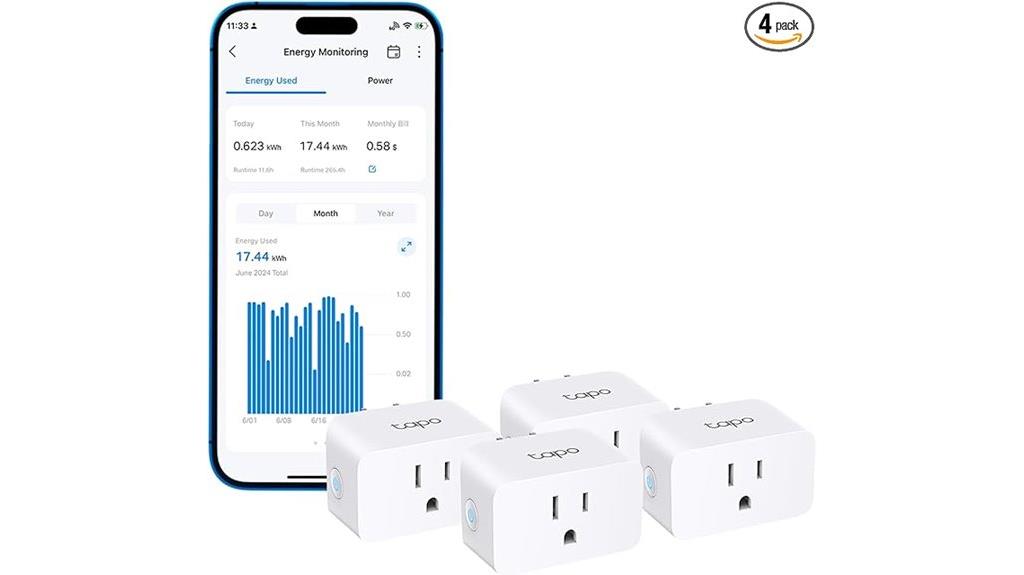
If you’re looking to monitor and control multiple devices effortlessly, the TP-Link Tapo Smart Plug 4-Pack with Energy Monitoring stands out as an excellent choice. It provides clear energy usage statistics and intuitive charts, helping you track power consumption accurately. You can estimate electric bills with detailed readings, set schedules, and enable auto-shutoff to prevent overloads. Compatibility with Alexa, Google Assistant, and Samsung SmartThings means voice control is simple. Its compact design fits well into most setups without blocking other outlets. Overall, this pack offers reliable energy management with easy remote control, making it a smart addition for anyone looking to cut costs and boost efficiency at home.
Best For: homeowners and tech enthusiasts seeking comprehensive energy monitoring and remote control of multiple devices to save on electricity costs and automate routines.
Pros:
- Accurate energy tracking with clear statistics and intuitive charts
- Supports programmable scheduling, timers, and auto-shutoff for safety and efficiency
- Compatible with Alexa, Google Assistant, and Samsung SmartThings for seamless voice and remote control
Cons:
- Larger size compared to mini smart plugs may limit placement in tight spaces
- Slightly higher price point than basic mini plugs without energy monitoring features
- Requires 2.4GHz Wi-Fi connection, which may not be available in all setups
Factors to Consider When Choosing Home Energy Monitoring Systems
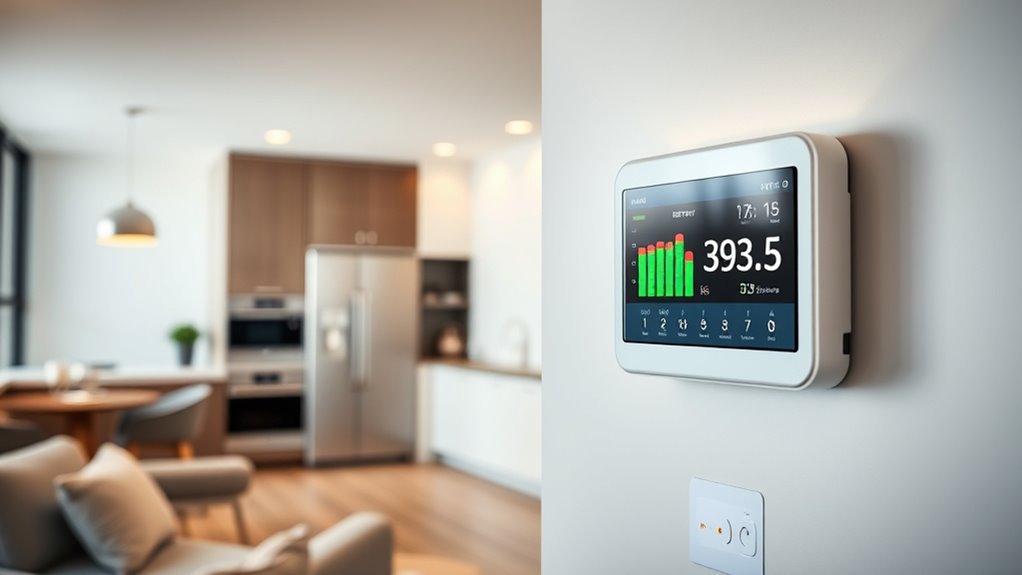
When choosing a home energy monitoring system, I consider how well it integrates with my existing home setup and its monitoring features. I also look at installation ease, data access, privacy, and how much it costs. These points help me find a system that fits my needs and budget perfectly.
Compatibility With Home Systems
Choosing a home energy monitoring system requires guaranteeing it can seamlessly integrate with your existing electrical setup and smart home devices. First, verify that the device supports your home’s electrical configuration—whether single-phase, split-phase, or three-phase—to ensure accurate data collection. Check if it connects easily via protocols like Wi-Fi, Zigbee, Z-Wave, or MQTT, so it communicates smoothly with your home automation system. Make sure the monitor’s voltage and current ratings match your household standards to prevent measurement errors or damage. Additionally, confirm compatibility with your circuit panel access points, such as busbar access or space for clamp-on sensors. Finally, consider whether it can integrate with smart plugs, thermostats, or other IoT devices, delivering a thorough and cohesive system.
Monitoring Capabilities
To make informed energy management decisions, it’s essential that a home energy monitoring system delivers real-time data on electricity usage. Accurate, instant insights help me identify consumption patterns and make adjustments. A good system measures parameters like voltage, current, power, and energy (kWh) precisely—within 1-2%—to guarantee reliable data. The ability to monitor individual appliances or circuits is a game-changer, allowing targeted troubleshooting and energy-saving efforts. I also value systems that offer remote access through mobile apps or web interfaces, so I can check my energy usage anytime, anywhere. Clear, real-time data empowers me to optimize my energy consumption, reduce waste, and cut costs effectively. Monitoring capabilities are the foundation of smart, efficient home energy management.
Installation Requirements
Installing a home energy monitoring system requires careful planning to guarantee safety and accuracy. First, you’ll often need to turn off the main power, especially when working inside electrical panels, so safety precautions are essential. Many systems use clamp-on sensors that must be securely attached around wires or busbars to ensure precise readings. Compatibility with your electrical setup—whether single-phase, split-phase, or three-phase—affects installation complexity and sensor placement. Some systems also need network setup via Wi-Fi or Ethernet, which might involve troubleshooting connectivity issues. Additionally, making sure there’s enough space inside your electrical panel and that sensors and cables are routed properly is vital for a clean, safe, and effective installation. Proper planning helps avoid errors and guarantees peak system performance.
Data Accessibility and Privacy
When evaluating home energy monitoring systems, understanding how they handle your data is just as important as their features. I look for systems that offer secure data encryption and adhere to strict privacy standards to keep my information safe. It’s vital they provide user-controlled data sharing options and clear privacy policies, so I maintain control over my energy data. I also prefer systems that support local storage, like on-premises servers or offline access, reducing dependence on cloud-based servers. Transparency about data collection practices matters—I want to know what data is gathered, how it’s used, and if third parties have access. Finally, I consider the company’s reputation and history regarding data privacy, ensuring my energy usage remains confidential.
Cost and Budgeting
Choosing a home energy monitoring system involves more than just looking at features; cost and budgeting play a crucial role in making the right choice. These systems vary widely in price, from under $50 to over $500, so it’s essential to set a clear budget. Remember, the initial cost isn’t everything—installation fees and potential professional help can add to the total expense. Some systems require subscription plans for data storage or premium features, which should be factored into your long-term costs. Additionally, the number of sensors, meters, or smart plugs you need will influence your overall expenditure. Picking a system within your budget ensures you get the best balance of features, accuracy, and affordability, preventing overspending on unnecessary capabilities.
Smart Integration Features
Smart integration features are essential for making your home energy monitoring system truly connected and convenient. These features allow seamless incorporation with popular platforms like Alexa, Google Assistant, and SmartThings, enabling voice control and automation. Many systems also support local network protocols such as MQTT, Zigbee, or Z-Wave, which means you can customize automation setups using platforms like Home Assistant. Compatibility with smart plugs, sensors, and other IoT devices provides appliance-level monitoring within a unified smart ecosystem. Advanced features often include real-time notifications, customizable alerts, and automated responses based on energy consumption patterns or device status. Plus, remote access through mobile apps ensures you can monitor and manage your energy data anytime, anywhere, making your home smarter and more efficient.
Frequently Asked Questions
How Do I Interpret Energy Consumption Data From These Monitors?
Interpreting energy consumption data might seem tricky at first, but I find it helpful to start by looking at daily and hourly usage patterns. I focus on sudden spikes or drops, which often indicate appliances that need attention. Comparing data over time shows me where I can cut back. I also pay attention to cost estimates, helping me prioritize which changes will save me the most money.
Are These Systems Compatible With All Home Wiring Types?
Back in the day, I thought all home wiring was the same, but these systems aren’t always universal. Most modern monitors are compatible with standard wiring types, like 120V or 240V circuits. However, older or specialized wiring might need adapters or professional installation. I recommend checking the product specs or consulting an electrician to guarantee compatibility, so you can monitor your energy use without any hiccups.
Can I Access Energy Data Remotely via Mobile Apps?
Absolutely, I can access energy data remotely via mobile apps with many modern systems. I love how convenient it is to check my energy usage on the go, whether I’m at work or on vacation. Most of these systems offer user-friendly apps compatible with smartphones, so I can monitor, analyze, and even control devices remotely. It’s a great way to stay on top of energy consumption and save money effortlessly.
What Is the Installation Process for These Energy Monitors?
When I install a home energy monitor, I start by turning off the power to safety. Then, I connect the device to my home’s electrical panel, following the manufacturer’s instructions. I typically mount the monitor in a central location and connect it to Wi-Fi. After powering everything up, I download the app, sync the device, and start tracking my energy use. It’s pretty straightforward and helps me monitor consumption easily.
How Do These Systems Help Identify Energy-Wasting Appliances?
Imagine discovering your old refrigerator is the biggest energy hog in your home. These systems help identify energy-wasting appliances by monitoring real-time usage and pinpointing anomalies. I’ve seen homeowners catch devices that run constantly or spike in power consumption. With this data, you can target specific appliances for upgrades or usage adjustments, ultimately saving money and reducing your energy footprint. It’s like having a personal energy detective!
Conclusion
Choosing the right energy monitor can gently steer your home toward smarter, more efficient habits. With these options, you’ll find a balance that suits your needs and makes saving energy feel effortless. Think of it as giving your home a subtle nudge toward greater sustainability, all while keeping costs in check. After all, small changes can lead to big, positive shifts — and I believe you’re just the right person to make it happen.
